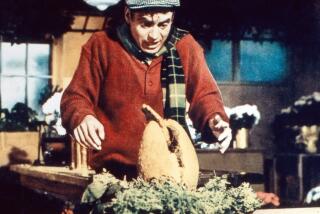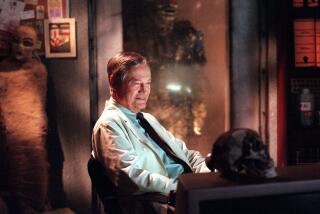HOW I MADE A HUNDRED MOVIES IN HOLLYWOOD AND NEVER LOST A DIME <i> by Roger Corman with Jim Jerome (Random House: $18.95; 206 pp.) </i>
- Share via
There was never a more aptly named autobiography than “How I Made a Hundred Movies in Hollywood and Never Lost a Dime,” written by the film maker who’s been called the King of the B Movies and the Pope of Pop Cinema. Roger Corman can boast--and does, on his first page--that his operation is on an unbelievable streak: 60 consecutive profitable movies.
Corman has made a success in every aspect of the business, from producing and directing such works as “The Little Shop of Horrors,” his Edgar Allan Poe films (“The Fall of the House of Usher” and “The Pit and the Pendulum,” among others) and his biker films (made with the real Hell’s Angels) to distributing his own films and others’.
“I am known for making films cheaply, quickly, profitably,” Corman writes succinctly, “and for finding innovative, unconventional ways of putting up on the screen an intangible ‘production value’ worth several times my films’ actual cost.” Although his hallmark is economy, he reminds readers that “my better films have been shown at prestigious festivals. . . . Moreover, at New World, while we churned out R-rated exploitation fare through the 1970s, I also found new and quite lucrative ways to import world-class art films from abroad, four of which won Best Foreign Film Oscars.” (The legendary producer/director and self-confessed “outlaw” film maker is still at it: His biggest-budget film ever, “Roger Corman’s Frankenstein,” is due for release over the Memorial Day weekend.)
Corman’s boasts, however--and much he has to boast about--begin and end in Chapter 1. The rest of the book (written with journalist Jim Jerome, co-author of “Papa John”) is devoted to storytelling--by Corman, about Corman, at Corman’s expense, at everyone else’s expense, but always to the greater glory of the art he practices so exuberantly. The overriding sense one gets from the torrent of stories told here is that film is treated too often with kid gloves, and that the success of Corman productions comes from never fearing to jump in and get dirty.
Corman’s own narrative is intercut with stories told by people who worked with him. Some of the best stories chronicle the early efforts of the host of famous film people who got their start under Corman’s tutelage: Martin Scorsese, Jonathan Demme, Ron Howard, John Sayles, Jack Nicholson and many others.
Here are riotous tales of feature-length films shot in a few days on shoestring budgets. “Hollywood Boulevard” was made when Jon Davison bet Corman that he could produce a picture for $50,000 less than anything Corman’s company had done. The film used stock footage from the studio, and young trailer-cutters Joe Dante and Allan Arkush got their first chance at directing. Abby Dalton recalls another mad production in which “Roger, on his way to setting his record, set up shots so quickly that one of the Viking girls in the background raced through a shot with her sunglasses on. No one even noticed.” When Martin Scorsese first met Corman, he expected to meet the maniacal, seat-of-the-pants yahoo type that the stories might suggest. “Instead,” Scorsese recalls, “I found him a very courteous and gentlemanly guy, but a very stern and tough customer who was quite polite as he explained these outrageous tactics of exploitation in cold, calm terms. . . . ‘Martin, (Corman told him,) it’s important that every fifteen pages there should be a touch of nudity or the suggestion thereof. Like a shoulder or leg exposed. It keeps the interest.’ ”
Corman’s autobiography employs the same successful technique as his films: It’s fast-paced, not overly intricate, and it tells a great story.
More to Read
Only good movies
Get the Indie Focus newsletter, Mark Olsen's weekly guide to the world of cinema.
You may occasionally receive promotional content from the Los Angeles Times.







